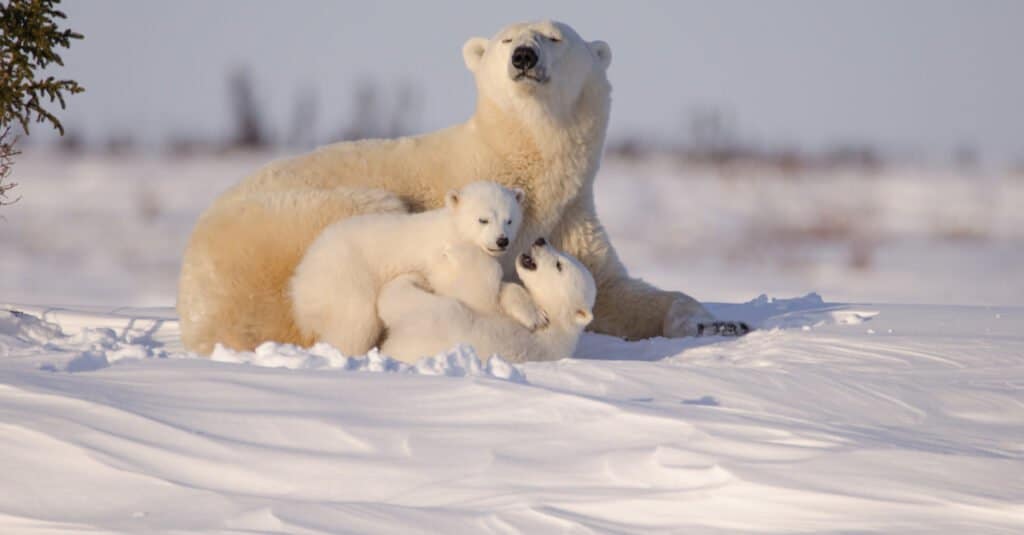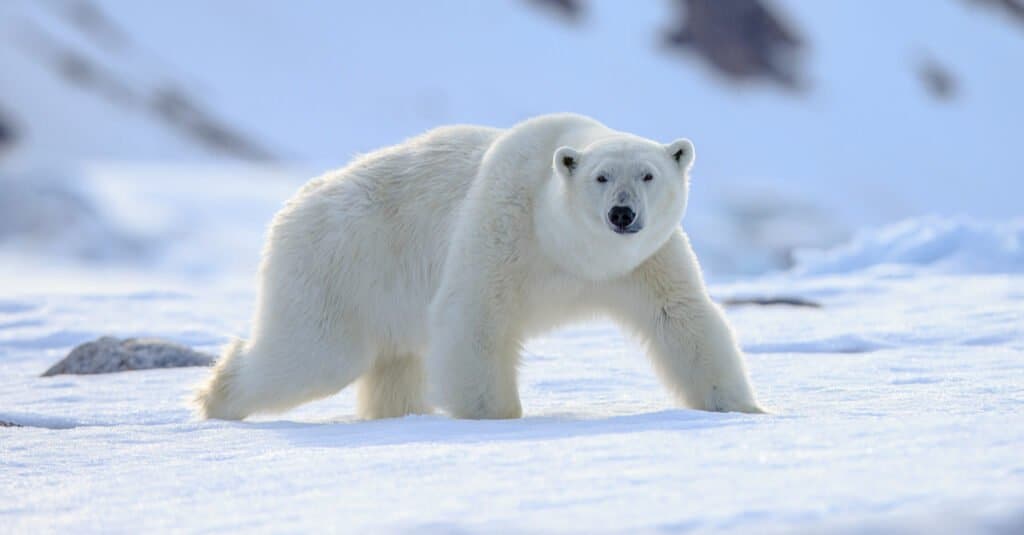Polar bears are an incredible, fascinating species. These mammals live in northern areas such as Alaska, Russia, and Canada, and feast on a wide variety of prey. They’re solitary by nature but have some important social interactions, including mating and play-fighting.
These bears are incredible swimmers and fighters. Their arctic adaptations equip them to deal with their preferred terrain’s harsh temperatures. Polar bears have thick fur (that’s translucent, not white!) that cushions them against the cold. However, due to climate change, polar bears have become endangered. Some scientists say it’s possible the species will go extinct by 2050 due to habitat loss from ice melting.
Polar bears are an astoundingly interesting species of bear. To fully grasp the way that polar bears move through daily life, it’s important to know about the differences between male and female polar bears. Polar bears are sexually dimorphic, meaning that different sexes exhibit different traits. There are some significant differences between male and female polar bears.
Here are six of the key differences between male and female polar bears!
| Characteristic | Male Polar Bears | Female Polar Bears |
|---|---|---|
| Height | 8-10 feet tall | 6-8 feet tall |
| Weight | 550-1750 lbs | 330-650 lbs |
| Maturity | Slower | Faster |
| Parenting Role | Absent | Present for up to 30 months |
| Aggression | Aggressive for food and mating | Defensive of young |
| Hierarchical Rank | Higher rank | Lower rank |
Male vs Female Polar Bears: Height

These male polar bears exhibit play-fighting behavior. It’s clear how tall they are!
©Pcb21 / Creative Commons – Original
One primary difference between male and female polar bears is their height. This trait is related to the fact polar bears are sexually dimorphic, or significantly different based on gender. Male polar bears are much taller than females, averaging between 8-10 feet in height. Female polar bears, however, are typically between 6-8 feet.
Sexually dimorphic traits generally exist due to natural selection. Because reproduction is related to social hierarchy for polar bears, and social hierarchy for male bears can be related to size and aggression, male polar bears generally find more success when they’re larger. As reproduction occurs over many, many generations, these adaptive differences become exacerbated, resulting in sexual dimorphism.
Male vs Female Polar Bears: Weight
Another way that sexual dimorphism shows up in the polar bear species is in weight. As discussed above, male polar bears are significantly larger than female polar bears in terms of height. The same is true for weight, with male polar bears sometimes weighing 4-6x more than females. Male polar bears generally weigh somewhere between 550-1750 pounds, whereas females only weigh between 350-650 pounds.
The size differential between male and female polar bears, then, is significant. Both in weight and height, female polar bears are significantly smaller than males. Size differences are a primary example of sexual dimorphism, shown in a lot of different breeds. Many mammals are sexually dimorphic, including humans! We see size differences between male and female humans just like we see them for polar bears.
Male vs Female Polar Bears: Maturity Timeline

Mothers remain with their cubs for months after they’re born.
©Anne Kiel/Shutterstock.com
Another key difference between male and female polar bears is the pace at which they reach maturity. Maturity in regards to an animal’s growth can mean a few different things. Polar bears see differences between the sexes in both size maturity and reproductive maturity.
Size Maturity
When it comes to reaching full size, males trail far behind. That, of course, makes some sense, given the fact that male polar bears are significantly larger than females. Male polar bears don’t reach their full size until they are between 8-10 years old. Keep in mind that polar bears have a lifespan of between 20-30 years, so a significant portion of a male polar bear’s life is spent growing. Female polar bears are fully grown when they are between 4 and 5 years of age. This means males take, on average, double the time to reach their full size.
Reproductive Maturity
Another key difference between male and female polar bears is the rate at which they reach sexual maturity. Similar to size maturity, males take quite a bit longer than females to reach reproductive maturity. Females are reproductively mature at around four years old, whereas males are reproductively mature at around six years old. Generally, females give birth to their first litter when they are between five and six years of age, whereas males do not participate in breeding until they are nearly double that.
For polar bears, breeding is intimately related to hierarchy. Male polar bears can exhibit aggression when trying to find a mate and, therefore, it serves the bear to wait until it is fully grown before it starts competing for a mate. Female polar bears often have to be pursued and, therefore, males will wait until they’ve reached full size before joining the race for a mate.
Male vs Female Polar Bears: Parenting Role
Male and female polar bears play significantly different roles in the rearing of baby polar bears, also called cubs. Female polar bears take the primary role in parenting, due to the nature of birth. After females become pregnant, they hibernate alone with their unborn cub. Cubs are born during hibernation, which means for the first few months of life, the mother and her cub are isolated. Male polar bears, as well as non-pregnant females, generally don’t den during hibernation. They, instead, enter a “walking hibernation,” which is more active.
Female polar bears often group up in maternity dens, which are dens dedicated to mothers and cubs. While polar bears are generally solitary animals, female polar bears find solace in groups of mothers and children. Males are not present in the den and, once they have impregnated their female mate, they will go their own way around a week after conception. Males are not active at all in the rearing of polar bear cubs.
The protection of cubs comes solely from female polar bears. In fact, in times of starvation, male polar bears have been willing to eat their own cubs to get by. With this in mind, female polar bears are the sole provider for young and vulnerable polar bear cubs.
Male vs Female Polar Bears: Aggression

Polar bears have black skin and translucent fur that appears white.
©Vaclav Sebek/Shutterstock.com
Both male and female polar bears engage in aggressive behavior from time to time. However, the cause of their aggression is vastly different. Female polar bears almost exclusively get aggressive in the protection of their young. Cubs are extremely vulnerable for many months after birth, and females need to protect them from not only prey but also male polar bears.
Male polar bears, however, do not have this protective instinct over their young. Instead, male polar bears exhibit aggression to either gain hierarchical rank or get food. They will play-fight one another to demonstrate dominance. Additionally, hungry male polar bears have been known to attack their own young to satiate their starvation. The vast majority of human attacks from polar bears have been hungry males.
During mating season, male polar bears can be aggressive with other male polar bears in pursuit of a female to mate. However, outside of mating season, male polar bears can entire alliances with one another and have a generally non-aggressive relationship.
Male vs Female Polar Bears: Hierarchical Rank
The hierarchy in polar bear groups is a bit nuanced. It’s not exclusively male-dominated and then female-dominated. Instead, the hierarchy is determined by a few different factors. Sex and age generally determine the flow of the hierarchy. Old males outrank old females, but adult females outrank young males. While polar bears are generally solitary, they can sometimes end up in groups on land, so hierarchy comes into play at times.
Male and female polar bears are distinct and unique from one another. Males are larger and more aggressive, while females are smaller and more protective of their young. Females mature quicker and take on the role of parenting, whereas males reach maturity slower and abandon their mates and young quickly.
The photo featured at the top of this post is © iStock.com/Alexey_Seafarer
Thank you for reading! Have some feedback for us? Contact the AZ Animals editorial team.







